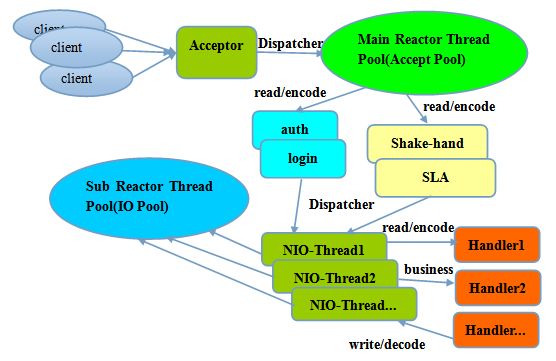跟着狼哥学高性能框架Netty
Posted 占小狼的博客
tags:
篇首语:本文由小常识网(cha138.com)小编为大家整理,主要介绍了跟着狼哥学高性能框架Netty相关的知识,希望对你有一定的参考价值。
简书 占小狼,转载请注明原创出处,谢谢!
前言
Netty是一个高性能、异步事件驱动的NIO框架,提供了对TCP、UDP和文件传输的支持,作为一个异步NIO框架,Netty的所有IO操作都是异步非阻塞的,通过Future-Listener机制,用户可以方便的主动获取或者通过通知机制获得IO操作结果。
作为当前最流行的NIO框架,Netty在互联网领域、大数据分布式计算领域、游戏行业、通信行业等获得了广泛的应用,一些业界著名的开源组件也基于Netty构建,比如RPC框架、zookeeper等。
不熟悉NIO的可以先看看下面两篇文章
1、
2、
那么,Netty性能为啥这么高?主要是因为其内部Reactor模型的实现。
Reactor模型
Netty中的Reactor模型主要由多路复用器(Acceptor)、事件分发器(Dispatcher)、事件处理器(Handler)组成,可以分为三种。
1、单线程模型:所有I/O操作都由一个线程完成,即多路复用、事件分发和处理都是在一个Reactor线程上完成的。
对于一些小容量应用场景,可以使用单线程模型。但是对于高负载、大并发的应用却不合适,主要原因如下:
一个线程同时处理成百上千的链路,性能上无法支撑,即便CPU负荷达到100%,也无法满足海量消息的编码、解码、读取和发送;
当负载过重后,处理速度将变慢,这会导致大量客户端连接超时,超时之后往往会进行重发,最终会导致大量消息积压和处理超时,成为系统的性能瓶颈;
一旦单线程意外跑飞,或者进入死循环,会导致整个系统通信模块不可用,不能接收和处理外部消息,造成节点故障,可靠性不高。
2、多线程模型:为了解决单线程模型存在的一些问题,演化而来的Reactor线程模型。

多线程模型的特点:
有专门一个Acceptor线程用于监听服务端,接收客户端的TCP连接请求;
网络IO的读写操作由一个NIO线程池负责,线程池可以采用标准的JDK线程池实现,包含一个任务队列和N个可用的线程,由这些NIO线程负责消息的读取、解码、编码和发送;
一个NIO线程可以同时处理多条链路,但是一个链路只能对应一个NIO线程,防止发生并发操作问题。
在绝大多数场景下,Reactor多线程模型都可以满足性能需求;但是,在极特殊应用场景中,一个NIO线程负责监听和处理所有的客户端连接可能会存在性能问题。例如百万客户端并发连接,或者服务端需要对客户端的握手消息进行安全认证,认证本身非常损耗性能。在这类场景下,单独一个Acceptor线程可能会存在性能不足问题,为了解决性能问题,产生了第三种Reactor线程模型-主从Reactor多线程模型。
3、主从多线程模型:采用多个reactor,每个reactor都在自己单独的线程里执行。如果是多核,则可以同时响应多个客户端的请求,一旦链路建立成功就将链路注册到负责I/O读写的SubReactor线程池上。

事实上,Netty的线程模型并非固定不变,在启动辅助类中创建不同的EventLoopGroup实例并通过适当的参数配置,就可以支持上述三种Reactor线程模型。正是因为Netty对Reactor线程模型的支持提供了灵活的定制能力,所以可以满足不同业务场景的性能需求。
示例代码
以下是server和client的示例代码,其中使用的是 Netty 4.x,先看看如何实现,后续会针对各个模块进行深入分析。
server 代码实现
public class EchoServer {
private final int port;
public EchoServer(int port) {
this.port = port;
}
public void run() throws Exception {
// Configure the server.
EventLoopGroup bossGroup = new NioEventLoopGroup(); // (1)
EventLoopGroup workerGroup = new NioEventLoopGroup();
try {
ServerBootstrap b = new ServerBootstrap(); // (2)
b.group(bossGroup, workerGroup)
.channel(NioserverSocketChannel.class) // (3)
.option(ChannelOption.SO_BACKLOG, 100)
.handler(new LoggingHandler(LogLevel.INFO))
.childHandler(new ChannelInitializer<SocketChannel>() { // (4)
@Override
public void initChannel(SocketChannel ch) throws Exception {
ch.pipeline().addLast(
//new LoggingHandler(LogLevel.INFO),
new EchoServerHandler());
}
});
// Start the server.
ChannelFuture f = b.bind(port).sync(); // (5)
// Wait until the server socket is closed.
f.channel().closeFuture().sync();
} finally {
// Shut down all event loops to terminate all threads.
bossGroup.shutdownGracefully();
workerGroup.shutdownGracefully();
}
}
public static void main(String[] args) throws Exception {
int port;
if (args.length > 0) {
port = Integer.parseInt(args[0]);
} else {
port = 8080;
}
new EchoServer(port).run();
}
}
EchoServerHandler 实现
public class EchoServerHandler extends ChannelInboundHandlerAdapter {
private static final Logger logger = Logger.getLogger(
EchoServerHandler.class.getName());
@Override
public void channelRead(ChannelHandlerContext ctx, Object msg) throws Exception {
ctx.write(msg);
}
@Override
public void channelReadComplete(ChannelHandlerContext ctx) throws Exception {
ctx.flush();
}
@Override
public void exceptionCaught(ChannelHandlerContext ctx, Throwable cause) {
// Close the connection when an exception is raised.
logger.log(Level.WARNING, "Unexpected exception from downstream.", cause);
ctx.close();
}
}
1、NioEventLoopGroup 是用来处理I/O操作的线程池,Netty对 EventLoopGroup 接口针对不同的传输协议提供了不同的实现。在本例子中,需要实例化两个NioEventLoopGroup,通常第一个称为“boss”,用来accept客户端连接,另一个称为“worker”,处理客户端数据的读写操作。
2、ServerBootstrap 是启动服务的辅助类,有关socket的参数可以通过ServerBootstrap进行设置。
3、这里指定NioServerSocketChannel类初始化channel用来接受客户端请求。
4、通常会为新SocketChannel通过添加一些handler,来设置ChannelPipeline。ChannelInitializer 是一个特殊的handler,其中initChannel方法可以为SocketChannel 的pipeline添加指定handler。
5、通过绑定端口8080,就可以对外提供服务了。
client 代码实现
public class EchoClient {
private final String host;
private final int port;
private final int firstMessageSize;
public EchoClient(String host, int port, int firstMessageSize) {
this.host = host;
this.port = port;
this.firstMessageSize = firstMessageSize;
}
public void run() throws Exception {
// Configure the client.
EventLoopGroup group = new NioEventLoopGroup();
try {
Bootstrap b = new Bootstrap();
b.group(group)
.channel(NioSocketChannel.class)
.option(ChannelOption.TCP_NODELAY, true)
.handler(new ChannelInitializer<SocketChannel>() {
@Override
public void initChannel(SocketChannel ch) throws Exception {
ch.pipeline().addLast(
//new LoggingHandler(LogLevel.INFO),
new EchoClientHandler(firstMessageSize));
}
});
// Start the client.
ChannelFuture f = b.connect(host, port).sync();
// Wait until the connection is closed.
f.channel().closeFuture().sync();
} finally {
// Shut down the event loop to terminate all threads.
group.shutdownGracefully();
}
}
public static void main(String[] args) throws Exception {
final String host = args[0];
final int port = Integer.parseInt(args[1]);
final int firstMessageSize;
if (args.length == 3) {
firstMessageSize = Integer.parseInt(args[2]);
} else {
firstMessageSize = 256;
}
new EchoClient(host, port, firstMessageSize).run();
}
}
EchoClientHandler 实现
public class EchoClientHandler extends ChannelInboundHandlerAdapter {
private static final Logger logger = Logger.getLogger(
EchoClientHandler.class.getName());
private final ByteBuf firstMessage;
/**
* Creates a client-side handler.
*/
public EchoClientHandler(int firstMessageSize) {
if (firstMessageSize <= 0) {
throw new IllegalArgumentException("firstMessageSize: " + firstMessageSize);
}
firstMessage = Unpooled.buffer(firstMessageSize);
for (int i = 0; i < firstMessage.capacity(); i ++) {
firstMessage.writeByte((byte) i);
}
}
@Override
public void channelActive(ChannelHandlerContext ctx) {
ctx.writeAndFlush(firstMessage);
}
@Override
public void channelRead(ChannelHandlerContext ctx, Object msg) throws Exception {
ctx.write(msg);
}
@Override
public void channelReadComplete(ChannelHandlerContext ctx) throws Exception {
ctx.flush();
}
@Override
public void exceptionCaught(ChannelHandlerContext ctx, Throwable cause) {
// Close the connection when an exception is raised.
logger.log(Level.WARNING, "Unexpected exception from downstream.", cause);
ctx.close();
}
}
------- END -------

每一次的思考
都想与你分享
点击阅读原文,查看更多
以上是关于跟着狼哥学高性能框架Netty的主要内容,如果未能解决你的问题,请参考以下文章